LLQQ ransomware virus is a new threat that every computer user should avoid
Contents
LLQQ ransomware is a new computer virus recently released by the notorious cybercriminals behind STOP/DJVU ransomware family. This latest version is similar to the earlier variants and can quickly encrypt all files stored in any computer once it is infected with it. In addition to that, it will also append .llqq extension to each of the corrupted file names. To elaborate further on this, a file that was originally saved as 1.jpg or 2.jpg would automatically become 1.jpg.llqq or 2.jpg.llqq and so on. Following that, messages known as _readme.txt will also be dropped in every folder. This is the method used by cybercriminals to let the victim know about the situation.
They will also claim that a very strong algorithm was used in the process; thus it can’t be breached except with their permission. Therefore, the victim would have to pay a certain amount of money as ransom in order to decrypt LLQQ files using tools provided by cybercriminals.

Contents of the ransom note
Prior to the release of the ransom notes, the victim may be wondering why their files have suddenly become encrypted. What could have gone wrong and possible way out, especially now that important documents, photos, and videos can no longer be accessed. For this reason, the virus drops notes with explanation in each affected data folder.
The cybercriminals would be anticipating their eagerness to find solutions and would, at this point, also make available two email addresses for communication. The emails are support@bestyourmail.ch and supportsys@airmail.cc. To make the victim pay the requested ransom without further hesitation, they will state that complying within a deadline of 72 hours would enable the victim to pay only half of the ransom fee, which is fixed at $490. However, failure to do so within that time limit means the maximum fee of $980 must be paid.
Also, being aware that what they’re doing is a criminal act that is punishable by law, they would avoid using any payment method that could expose their identity. This is the reason why they always demand for payment to be made using cryptocurrency. A wallet address would be forwarded to the victim and would be told to transfer the crypto value of the ransom fee into it.
The cybercriminals would also suggest that excerpts of the encrypted files could be forwarded by the victim for possible test decryption. However, they will reserve the right to provide the result or not, depending if they consider it to be random texts or crucial information to the victim. These are some of the mind games they play with their victims.

No matter how difficult the situation might be to the victim, the FBI, in agreement with other renowned cyber-security organizations have warned that victims shouldn’t pay ransom. Several reasons were given for why they took such a stand, but here are the major ones:
- Paying ransom is no guarantee that encrypted files will be restored by cybercriminals.
- It often leads to future extortions.
- Ransom payments make crime profitable for those that indulge in it.
- More funds at the disposal of cybercriminals would help them to increase their capacity.
More details regarding this crypto-malware
It is curious to note that despite operating globally, the cybercriminals behind STOP/DJVU ransomware usually avoid certain countries. These countries are located in the Middle East and Eastern Europe, and have been listed as Russia, Syria, Belarus, Armenia, Kyrgyzstan, Ukraine, Uzbekistan, Kazachstan, and Tajikistan. To effectively carry out the operation, a connection would be made using https[:]//api.2ip.ua/geo.json and the outcome saved in the geo.json file. These would include country name, city, IP address, zip code, latitude, and longitude. It is such pieces of information that would determine if the cyber-attack would proceed or not.
As if data encryption by the LLQQ virus is not bad enough, there is also a threat of RATs infection. RAT stands for Remote Access Trojans and could be used to steal vital information such as cryptocurrency wallets, banking details, software login credentials, passwords etc. The loss of such sensitive information could put the victim at risk of fraud, blackmail etc. The most common RATs associated with STOP/DJVU ransomware are VIDAR and AZORULT.
If you’re already a victim of this computer malware, you’re advised to remove LLQQ ransomware as soon as possible to contain its destructive effects. The method you can adopt is to login to your computer through Safe Mode with Networking before activating genuine antivirus software. In addition to that, you can as well consider the use of RESTORO in trying to recover some of the damaged operating system files.
Ransomware Summary
| Name | LLQQ Ransomware Virus |
| Type | Ransomware; Crypto-malware; Virtual Extortion Virus |
| Family | STOP/DJVU |
| Encryption type | RSA 2048 + Salsa20 |
| Previous versions | KAAA, BGJS, BGZQ (find full list here) |
| Version | 507th |
| Extension | .llqq |
| Cybercriminal emails | support@bestyourmail.ch and supportsys@airmail.cc |
| Additional malware dropped | Azorult or Vidar Trojan |
| Damage | The ransomware uses encryption to maliciously modify all files on the PC and marks their original names with .llqq extension. Ransom notes called as _readme.txt will be dropped in every computer folder. This piece of malware usually drags VIDAR Stealer alongside it and also eliminates VSS from the system. On top of that, it tends to modify Windows HOSTS file to restrict computer user’s access to cybersecurity-related websites online. |
| Ransom note | _readme.txt |
| Ransom demand | $490-$980 in Bitcoin |
| Distribution | Victims often download this ransomware along illegal torrent downloads, cracked software, activators, key generators or tools like KMSPico. |
| Known software cracks to contain this malware | Corel Draw, Tenorshare 4ukey, Adobe Photoshop, Cubase, Adobe Illustrator, Internet Download Manager, Tally, League of Legends. |
| Detection names | Ransom:Win32/StopCrypt.PAL!MTB (Microsoft), Trojan.Crypt (A) (Emsisoft), HEUR:Trojan-Ransom.Win32.Stop.gen (Kaspersky), Trojan.GenericKD.47850419 (BitDefender), Trojan.MalPack.GS (Malwarebytes), ML.Attribute.HighConfidence (Symantec) see all detection name variations on VirusTotal |
| Removal | Remove ransomware and related malware from your PC using trustworthy software. To repair virus damage on Windows OS files, consider scanning with RESTORO (secure download link). |
REPAIR VIRUS DAMAGE
Scan your system for FREE to detect security, hardware and stability issues. You can use the scan results and try to remove threats manually, or you can choose to get the full version of software to fix detected issues and repair virus damage to Windows OS system files automatically. Includes Avira spyware/malware detection & removal engine.
The screenshot provided below depicts how files encrypted by this virus look like.

Effective ways to prevent LLQQ ransomware virus infection
There are diverse loopholes cybercriminals exploit when distributing STOP/DJVU malware but the major ones are through cloned software contents uploaded on dubious online torrent platforms as well as use of emails and attachments. Therefore, any illegal online torrent platform is considered a huge risk factor that should be avoided.
From our records so far, majority of STOP/DJVU ransomware victims reported visiting online torrent platforms prior to detecting malware in their computers. They had wanted to download needed software contents but failed to do the right thing. They felt it would be cost-effective to download such software contents freely without knowing they were embedded with malware. We also noted that cybercriminals often clone software contents that are in high demand and use them to trap unsuspecting victims. The list below captures some of the popular software contents that are often cloned by cybercriminals:
- Cubase;
- Adobe Illustrator;
- Corel Draw;
- Adobe Premiere Pro,
- AutoCad;
- Adobe Photoshop,
- Internet Download Manager;
- League of Legends;
- Tenorshare 4ukey;
- VMware Workstation.
Recently, some computer users also reported that KMSpico versions they tried to download were embedded with ransomware variants. Therefore, it is in the best interest of computer users to download needed software copies from the official web pages of the original content producers or their affiliated partners.
There is also need to apply caution when opening emails, especially when you’re not absolutely sure of its authenticity. Also note that cybercriminals keep changing their gimmicks in an attempt to deceive their target audience. They often impersonate as friends/acquaintances or claim to be representatives of popular brands like DHL, Amazon, and FedEx etc. Other times, they may decide to obfuscate the sender’s address. Files like PDF, XLS or DOCX often come handy to them because they can be used for macro functions. Emails that fall within any of the categories mentioned above should not be opened.
At this point, it is necessary to point out that STOP/DJVU ransomware victims should ignore dubious adverts by different brands claiming to offer decryption tools. Most of such adverts are from cybercriminals trying to rip-off victims. However, DiskTuna and Emsisoft have shown promising results in file decryption.
LLQQ Ransomware Removal and File Decryption Tips
Ransomware encryption of personal files can be quite upsetting, that is why it is very important for you to remove LLQQ ransomware virus as soon as possble while also taking remedial measures. It has been stated that setting up your computer on Safe Mode with Networking before scanning an antivirus is the way to go. There is also the option of using RESTORO to salvage some of the corrupted Windows OS files.
Once LLQQ ransomware virus removal is complete, you should take the following steps:
- Let the local police know about the situation.
- Use any available backup device to reclaim lost files.
- Get to know more about STOP/DJVU encrypted files and how to repair them.
- Change all passwords immediately.
OUR GEEKS RECOMMEND
Our team recommends removing malware using a professional antivirus software.
REMOVE THREATS WITH ROBUST ANTIVIRUS

Get INTEGO ANTIVIRUS for Windows to remove ransomware, Trojans, adware and other spyware and malware variants and protect your PC and network drives 24/7. This VB100-certified security software uses state-of-art technology to provide protection against ransomware, Zero-Day attacks and advanced threats, Intego Web Shield blocks dangerous websites, phishing attacks, malicious downloads and installation of potentially unwanted programs.
Use INTEGO Antivirus to remove detected threats from your computer.
GeeksAdvice.com editors select recommended products based on their effectiveness. We may earn a commission from affiliate links, at no additional cost to you. Learn more.
LLQQ Ransomware Virus Removal Guidelines
Method 1. Enter Safe Mode with Networking
Step 1. Start Windows in Safe Mode with Networking
Before you try to remove LLQQ Ransomware Virus virus, you must start your computer in Safe Mode with Networking. Below, we provide the easiest ways to boot PC in the said mode, but you can find additional ones in this in-depth tutorial on our website – How to Start Windows in Safe Mode. Also, if you prefer a video version of the tutorial, check our guide How to Start Windows in Safe Mode on Youtube.
Instructions for Windows XP/Vista/7 users
- First of all, turn off your PC. Then press the Power button to start it again and instantly start pressing F8 button on your keyboard repeatedly in 1-second intervals. This launches the Advanced Boot Options menu.
- Use arrow keys on the keyboard to navigate down to Safe Mode with Networking option and press Enter.

Instructions for Windows 8/8.1/10/11 users
- Open Windows Start menu, then press down the Power button. On your keyboard, press down and hold the Shift key, and then select Restart option.

- This will take you to Windows Troubleshoot screen. Choose Troubleshoot > Advanced Options > Startup Settings > Restart. Tip: If you can't find Startup Settings, click See more recovery options.

- In Startup Settings, press the right key between F1-F9 to enter Safe Mode with Networking. In this case, it is the F5 key.

Step 2. Remove files associated with the virus
Now, you can search for and remove LLQQ Ransomware Virus files. It is very hard to identify files and registry keys that belong to the ransomware virus, Besides, malware creators tend to rename and change them repeatedly. Therefore, the easiest way to uninstall such type of a computer virus is to use a reliable security program such as INTEGO Antivirus. For virus damage repair, consider using RESTORO.
Special Offer
Compatibility: Microsoft Windows
See Full Review
RESTORO is a unique PC Repair Tool which comes with an in-built Avira scan engine to detect and remove spyware/malware threats and uses a patented technology to repair virus damage. The software can repair damaged, missing or malfunctioning Windows OS files, corrupted DLLs, and more. The free version offers a scan that detects issues. To fix them, license key for the full software version must be purchased.
Method 2. Use System Restore
In order to use System Restore, you must have a system restore point, created either manually or automatically.
Step 1. Boot Windows in Safe Mode with Command Prompt
Instructions for Windows XP/Vista/7 users
- Shut down your PC. Start it again by pressing the Power button and instantly start pressing F8 button on your keyboard repeatedly in 1-second intervals. You will see Advanced Boot Options menu.
- Using arrow keys on the keyboard, navigate down to Safe Mode with Command Prompt option and press Enter.

Instructions for Windows 8/8.1/10/11 users
- Launch Windows Start menu, then click the Power button. On your keyboard, press down and hold the Shift key, and then choose Restart option with the mouse cursor.

- This will take you to Windows Troubleshoot screen. Choose Troubleshoot > Advanced Options > Startup Settings > Restart. Tip: If you can't find Startup Settings, click See more recovery options.

- In Startup Settings, press the right key between F1-F9 to enter Safe Mode with Command Prompt. In this case, press F6 key.

Step 2. Start System Restore process
- Wait until system loads and command prompt shows up.
- Type cd restore and press Enter, then type rstrui.exe and press Enter. Or you can just type %systemroot%system32restorerstrui.exe in command prompt and hit Enter.

- This launches System Restore window. Click Next and then choose a System Restore point created in the past. Choose one that was created before ransomware infection.

- Click Yes to begin the system restoration process.
After restoring the system, we recommend scanning the system with antivirus or anti-malware software. In most cases, there won't be any malware remains, but it never hurts to double-check. In addition, we highly recommend checking ransomware prevention guidelines provided by our experts in order to protect your PC against similar viruses in the future.
Alternative software recommendations
Malwarebytes Anti-Malware
Removing spyware and malware is one step towards cybersecurity. To protect yourself against ever-evolving threats, we strongly recommend purchasing a Premium version of Malwarebytes Anti-Malware, which provides security based on artificial intelligence and machine learning. Includes ransomware protection. See pricing options and protect yourself now.

System Mechanic Ultimate Defense
If you're looking for an all-in-one system maintenance suite that has 7 core components providing powerful real-time protection, on-demand malware removal, system optimization, data recovery, password manager, online privacy protection and secure driver wiping technology. Therefore, due to its wide-range of capabilities, System Mechanic Ultimate Defense deserves Geek's Advice approval. Get it now for 50% off. You may also be interested in its full review.

Disclaimer. This site includes affiliate links. We may earn a small commission by recommending certain products, at no additional cost for you. We only choose quality software and services to recommend.
Decrypt LLQQ files
Fix and open large LLQQ files easily:
It is reported that STOP/DJVU ransomware versions encrypt only the beginning 150 KB of each file to ensure that the virus manages to affect all files on the system. In some cases, the malicious program might skip some files at all. That said, we recommend testing this method on several big (>1GB) files first.
- Create a copy of encrypted file to a separate folder using Copy > Paste commands.
- Now, right-click the created copy and choose Rename. Select the LLQQ extension and delete it. Press Enter to save changes.
- In the prompt asking whether you want to make the changes as file might become unusable, click OK.
- Try opening the file.
STOP/DJVU decryption tool usage guide
STOP/DJVU ransomware versions are grouped into old and new variants. LLQQ Ransomware Virus is considered the new STOP/DJVU variant, just like KAAA, BGJS, BGZQ (find full list here). This means full data decryption is now possible only if you have been affected by offline encryption key. To decrypt your files, you will have to download Emsisoft Decryptor for STOP DJVU, a tool created and maintained by a genius security researcher Michael Gillespie.
Note! Please do not spam the security researcher with questions whether he can recover your files encrypted with online key - it is not possible.
In order to test the tool and see if it can decrypt LLQQ files, follow the given tutorial.
- Download the decryption tool from Emsisoft.
- Click the little arrow next to your download and choose Show in Folder.
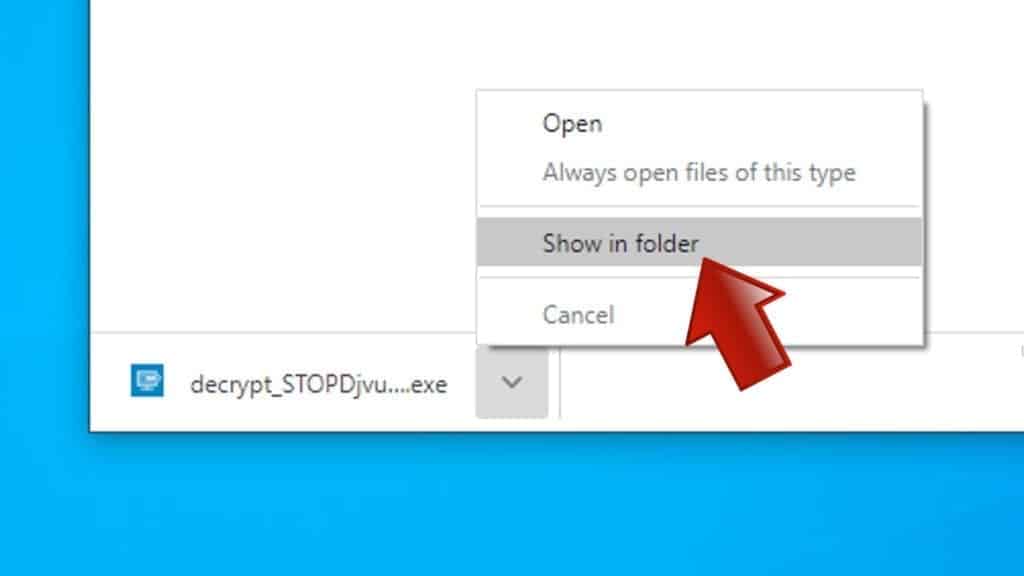
- Now, right-click the file and choose Run as Administrator. If asked, enter administrator's password.
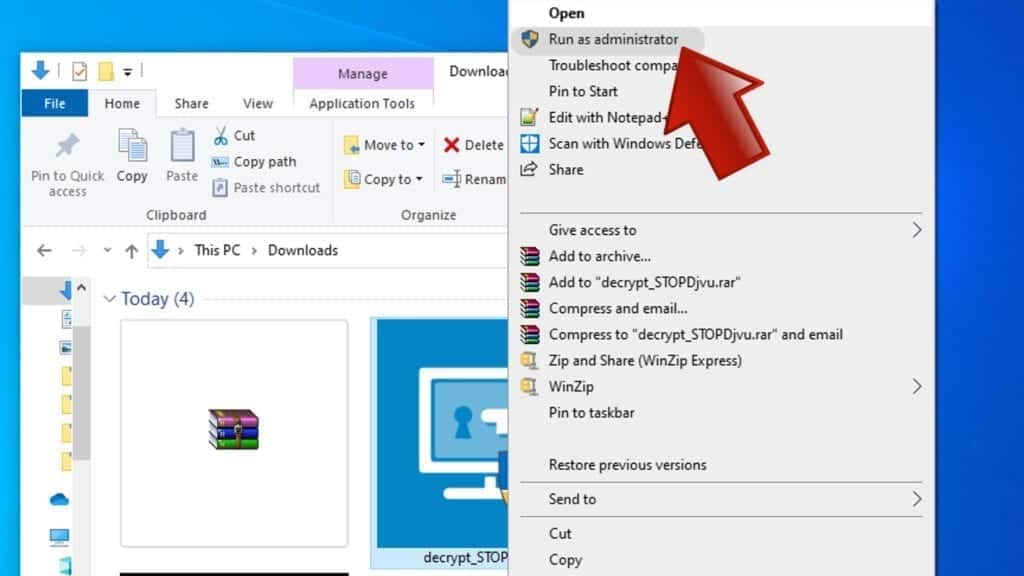
- In UAC window, click Yes.
- Click Yes to agree to software terms in both windows.
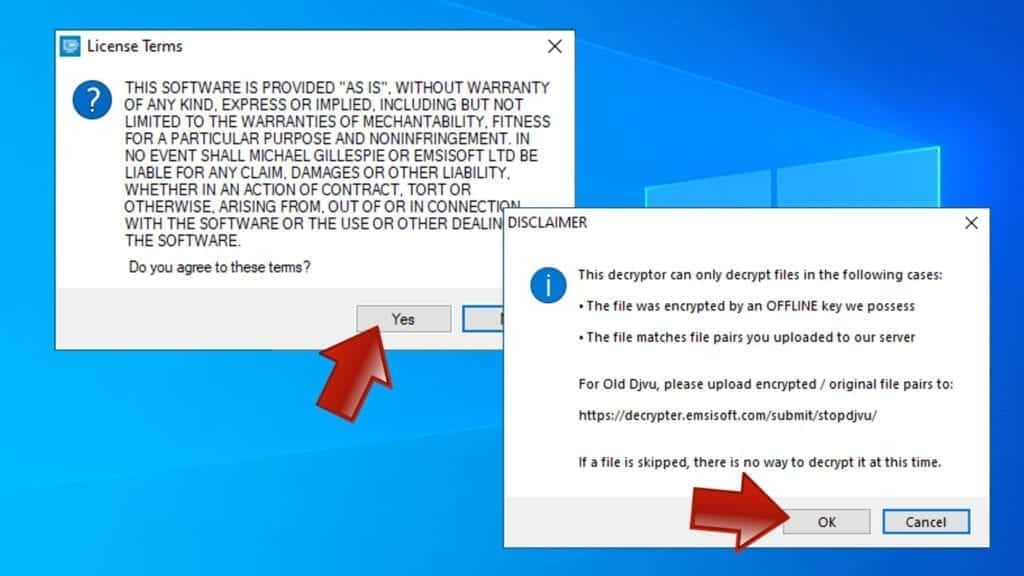
- The tool will automatically include C:// disk as a location to decrypt. The file recovery tool will prepopulate the locations to scan, including connected data storage drives or network drives. Click Add folder if you wish to add additional locations.
In Options tab, you can choose to keep encrypted file copies. We recommend leaving this option selected, especially if you do not know if the decryption tool will work.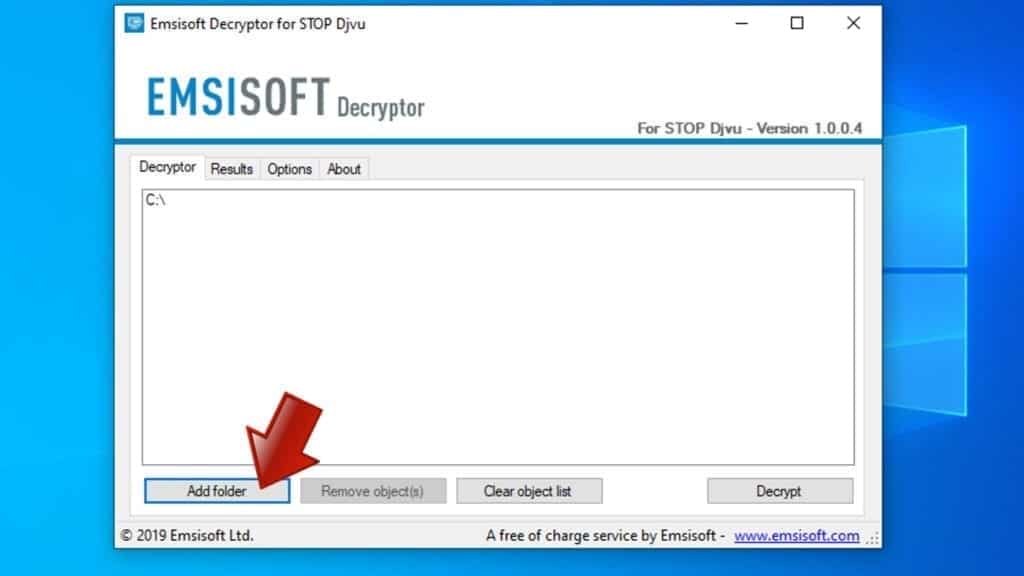
- Click Decrypt to start restoring LLQQ files. You will see the progress in the Results tab. Here, you can see messages from the tool, such as whether the decryption procedure is successful, or you need to wait for an update.
You might also be informed that online key was used to encrypt your files. In such case, the decryption tool won't work for you, and the only way to recover your files is to use a data backup.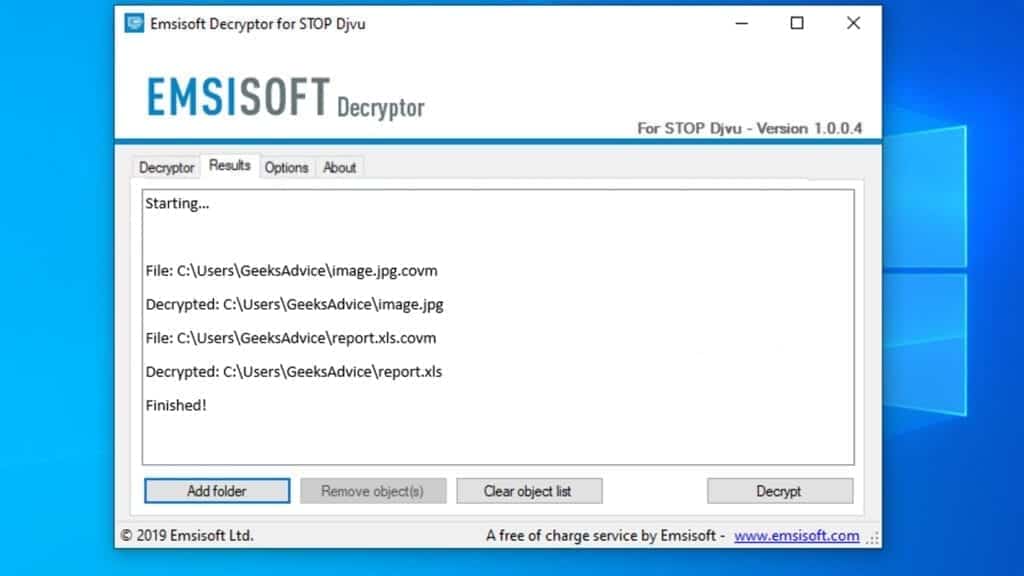
Meanings of decryptor's messages
The LLQQ decryption tool might display several different messages after failed attempt to restore your files. You might receive one of the following messages:
Error: Unable to decrypt file with ID: [example ID]
This message typically means that there is no corresponding decryption key in the decryptor's database.
No key for New Variant online ID: [example ID]
Notice: this ID appears to be an online ID, decryption is impossible
This message informs that your files were encrypted with online key, meaning no one else has the same encryption/decryption key pair, therefore data recovery without paying the criminals is impossible.
Result: No key for new variant offline ID: [example ID]
This ID appears to be an offline ID. Decryption may be possible in the future.
If you were informed that an offline key was used, but files could not be restored, it means that the offline decryption key isn't available yet. However, receiving this message is extremely good news, meaning that it might be possible to restore your LLQQ extension files in the future. It can take a few months until the decryption key gets found and uploaded to the decryptor. We recommend you to follow updates regarding the decryptable DJVU versions here. We strongly recommend backing up your encrypted data and waiting.
Report Internet crime to legal departments
Victims of LLQQ Ransomware Virus should report the Internet crime incident to the official government fraud and scam website according to their country:
- In the United States, go to the On Guard Online website.
- In Australia, go to the SCAMwatch website.
- In Germany, go to the Bundesamt für Sicherheit in der Informationstechnik website.
- In Ireland, go to the An Garda Síochána website.
- In New Zealand, go to the Consumer Affairs Scams website.
- In the United Kingdom, go to the Action Fraud website.
- In Canada, go to the Canadian Anti-Fraud Centre.
- In India, go to Indian National Cybercrime Reporting Portal.
- In France, go to the Agence nationale de la sécurité des systèmes d’information.
If you can't find an authority corresponding to your location on this list, we recommend using any search engine to look up "[your country name] report cyber crime". This should lead you to the right authority website. We also recommend staying away from third-party crime report services that are often paid. It costs nothing to report Internet crime to official authorities.
Another recommendation is to contact your country's or region’s federal police or communications authority.
Frequently Asked Questions
You can only open LLQQ files if you have the decryption key, or if you were affected by offline encryption type.
To figure out whether you were affected by offline encryption, please go to C:/SystemID/PersonalID.txt and see if the string inside of it ends in t1. You can also try using Emsisoft Decryptor for STOP/DJVU.
Please follow the guidances provided by the official LLQQ decryption tools and believe what they say. If they say it is impossible to decrypt, it really is so. There is no magic tool or human capable of decrypting your files hiding somewhere. Encryption is a technique created to be nearly impossible to decrypt without a special private key (held by the criminals).
We advise scanning with anti-virus, anti-malware, malware removal tools or software like RESTORO to eliminate virus damage on the system. If you do not trust using a single tool, try running one after another. However, we do not recommend keeping several security programs on a computer at once as they can interfere with each other's work.
Beware of fake LLQQ decryption tools circulating around the web. Cyber criminals are uploading them to various shady websites, also might be promoting them via suspicious Youtube videos. These programs can infect your computer even more heavily (Trojans, miners, etc.). We suggest being extremely cautious around the web. If there will be an official STOP/DJVU decryption tool available, it will be widely discussed in public media.

Norbert Webb is the head of Geek’s Advice team. He is the chief editor of the website who controls the quality of content published. The man also loves reading cybersecurity news, testing new software and sharing his insights on them. Norbert says that following his passion for information technology was one of the best decisions he has ever made. “I don’t feel like working while I’m doing something I love.” However, the geek has other interests, such as snowboarding and traveling.
Leave a Reply